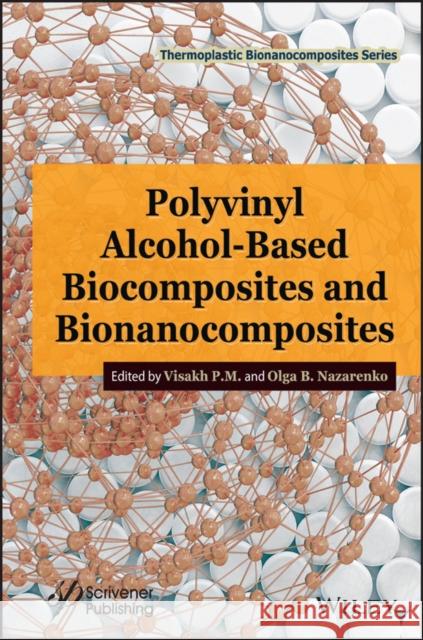Polyvinyl Alcohol-Based Biocomposites and Bionanocomposites » książka



Polyvinyl Alcohol-Based Biocomposites and Bionanocomposites
ISBN-13: 9781119592099 / Angielski / Twarda / 2023 / 400 str.
Polyvinyl Alcohol-Based Biocomposites and Bionanocomposites
ISBN-13: 9781119592099 / Angielski / Twarda / 2023 / 400 str.
(netto: 782,22 VAT: 5%)
Najniższa cena z 30 dni: 817,95
ok. 30 dni roboczych
Dostawa w 2026 r.
Darmowa dostawa!
Preface xi1 Polyvinyl Alcohol-Based Biocomposites and Bionanocomposites: State-of-the-Art, New Challenges and Opportunities 1Visakh P. M.1.1 Biodegradation Study of Polyvinyl Alcohol-Based Biocomposites and Bionanocomposites 11.2 Polyvinyl Alcohol-Based Biocomposites and Bionanocomposites: Significance and Applications, Practical Step Toward Commercialization 41.3 Polyvinyl Alcohol/Cellulose-Based Biocomposites and Bionanocomposites 71.4 Polyvinyl Alcohol/Starch-Based Biocomposites and Bionanocomposites 91.5 Polyvinyl Alcohol/Polylactic Acid-Based Biocomposites and Bionanocomposites 111.6 Biomedical Applications of Polyvinyl Alcohol-Based Bionanocomposites 131.7 Hybrid Interpolymeric Complexes 16References 182 Biodegradation Study of Polyvinyl Alcohol-Based Biocomposites and Bionanocomposites 31Zahid Majeed, Muhammad Mubashir, Pau Loke Show and Eefa Manzoor2.1 Introduction 322.2 Biodegradable PVA Biocomposites and Bionanocomposites 382.2.1 PVA/Cellulose-Based Biocomposites and Bionanocomposites 392.2.2 PVA/Chitin-Based Biocomposites and Bionanocomposites 402.3 PVA/Starch-Based Biocomposites and Bionanocomposites 422.4 PVA/Hemicellulose-Based Biocomposites and Bionanocomposites 452.5 PVA/Polylactic Acid-Based Biocomposites and Bionanocomposites 482.6 PVA/Polyhydroxyalkanoates-Based Biocomposites and Bionanocomposites 492.7 Conclusion 51References 523 Polyvinyl Alcohol-Based Bionanocomposites: Significance and Applications, Practical Step Towards Commercialization 59S. Mohanapriya3.1 Introduction: Polyvinyl Alcohol (PVA) 603.2 Properties of PVA 613.3 PVA Composites and Nancomposites 613.3.1 Fabrication of PVA-Based Composites and Bionanocomposites 643.4 Categorization and Advantages of PVA Composites 653.5 Issues Associated with PVA-Based Composites/Nanocomposites 663.6 Diverse Applications of PVA-Based Composites/Nanocomposites 663.6.1 Biomedical Applications 663.6.1.1 Wound Dressing Material 683.6.2 Cartilage and Orthopedic Applications 683.6.3 Electrochemical Applications 693.6.4 Optical and Photonic Applications 713.6.5 Renewable Energy Source-Based Applications 713.6.6 Food Packaging Applications 743.7 PVA Composites/Nanocomposites: Future Outlook 76References 764 Polyvinyl Alcohol/Cellulose-Based Biocomposites and Bionanocomposites 81Nor Asikin Awang, Mohamad Azuwa Mohamed and Wan Norharyati Wan Salleh4.1 Introduction 824.2 Polyvinyl Alcohol/Cellulose-Based Biocomposites and Bionanocomposites and Their Preparation 844.2.1 Polyvinyl Alcohol/Cellulose Fibers 844.2.2 Polyvinyl Alcohol/Cellulose Acetate 864.2.3 Polyvinyl Alcohol/Bacterial Cellulose 874.2.4 Polyvinyl Alcohol/Regenerated Cellulose 904.2.5 Polyvinyl Alcohol/Cellulose Aerogel or Hydrogel 924.2.6 Polyvinyl Alcohol/Cellulose Nanocrystals 944.2.7 Polyvinyl Alcohol/Cellulose Nanofiber 964.3 Properties and Characterizations Techniques 984.3.1 Tensile Characterizations 984.3.2 Thermal Characterizations 994.3.3 X-Ray Diffraction 1004.3.4 Morphological Characterizations 1014.3.5 Rheological and Viscoelastic Characterizations 1044.4 Potential Applications 1084.4.1 Biomedical Applications 1084.4.2 Packaging Applications 1104.4.3 Heavy Metal Applications 1134.4.4 Gas Separation 1144.5 Conclusion 116References 1165 Polyvinyl Alcohol/Starch-Based Biocomposites and Bionanocomposites 131Nor Fasihah Binti Zaaba and Hanafi Bin Ismail5.1 Introduction 1315.2 Polyvinyl Alcohol/Starch-Based Biocomposites and Bionanocomposites 1325.3 Preparation 1345.4 Characterizations 1355.4.1 Mechanical Properties 1355.4.2 Fourier Transform Infrared (FTIR) Spectroscopy 1375.4.3 Differential Scanning Calorimetry 1385.4.4 Thermogravimetric Analysis 1415.5 Applications 1435.6 Conclusion 143References 1446 Polyvinyl Alcohol/Polylactic Acid-Based Biocomposites and Bionanocomposites 151Ashitha Jose and Radhakrishnan E.K.6.1 Introduction 1526.2 PVA Composites and Bionanocomposites 1536.3 Poly Lactic Acid (PLA) Composites and Bionanocomposites 1556.4 The Role of Plasticizers and Fillers in Composite Development 1576.5 Methods Employed in the Development of Structured Polymers 1586.5.1 Melt Compounding 1586.5.2 Solvent-Based Methods 1586.5.3 Electrospinning 1586.5.3.1 Melt Electrospinning 1596.5.3.2 Near Field Electrospinning (NFES) 1606.5.3.3 Electrohydrodynamic (EHD) 1606.5.3.4 Coelectrospinning 1616.6 Techniques for Analyzing the Biocomposites and Bionanocomposites 1626.6.1 FTIR 1626.6.2 Thermal Properties of Films 1636.6.3 Scanning Electron Microscopy 1646.6.4 TEM 1656.6.5 Barrier Properties 1656.6.5.1 Light Barrier Properties and Transparency 1656.6.5.2 Oxygen Barrier Properties 1656.6.5.3 Water Vapour Barrier Property 1666.7 Application of Polymers in Food Industry 1676.8 Application of Polymers in Medicine 1686.9 Biodegradability of PVA 1706.10 Conclusions 174References 1757 Biomedical Applications of Polyvinyl Alcohol-Based Bionanocomposites 179Bruno Leandro Pereira, Viviane Seba Sampaio, Gabriel Goetten de Lima, Carlos Maurício Lepienski, Mozart Marins, Bor Shin Chee and Michael J. D. Nugent7.1 Introduction 1807.2 Application in Drug Delivery Systems 1817.3 Applications in Wound Healing 1847.4 Applications in Tissue Engineering 1897.5 Applications in Regenerative Medicine 1927.6 Conclusions and Future Perspectives 193References 1948 Hybrid Interpolymeric Complexes 205Igor Prosanov8.1 Introduction 2058.1.1 Historical Overview 2058.1.2 General Description of HICs 2078.1.3 Relative Materials 2108.1.4 To Summarize 2118.2 Production of HICs 2118.2.1 To Summarize 2158.3 Structure of Hybrid Interpolymeric Complexes 2158.3.1 General Description of Experimental Methods and Computations 2158.3.2 Halides of Second Group Elements as HICs Components 2178.3.2.1 Cadmium Halides Based HICs 2208.3.2.2 Zinc Halides Based HICs 2278.3.3 Sulfides as HICs Components 2278.3.4 Boric Acid as HIC Component 2308.3.5 Copper Hydroxide/Oxide as HIC Component 2328.3.6 Hydroxides and Oxides Other then Copper Elements as HICs Components 2368.3.7 To Summarize 2438.4 Possible Applications of HICs 2438.4.1 To Summarize 2478.5 Conclusion 248References 248Index 253
Visakh P.M., PhD, has been an assistant professor at TUSUR University, Tomsk, Russia since 2017. He completed his Post doc. research at Tomsk Polytechnic University, Russia (2014-2017). He obtained his PhD from the School of Chemical Sciences, Mahatma Gandhi University, Kottayam, Kerala, India. He has edited 35 books and published more than 25 journal articles, four review articles, and more than 30 book chapters.Olga Nazarenko, PhD, is a professor in the Division for Testing and Diagnostics, School of Non-Destructive Testing, Tomsk Polytechnic University, Russia. Her first degree was in electrical engineering (1985), followed by a PhD in high voltage technique (1996) and DSc in chemical engineering (2007). Her areas of interest include metals and chemical compounds nanopowders--production, their characterization, and application, electrical explosion of wires, polymer composites, and fire-retardant polymers.
1997-2025 DolnySlask.com Agencja Internetowa
KrainaKsiazek.PL - Księgarnia Internetowa









